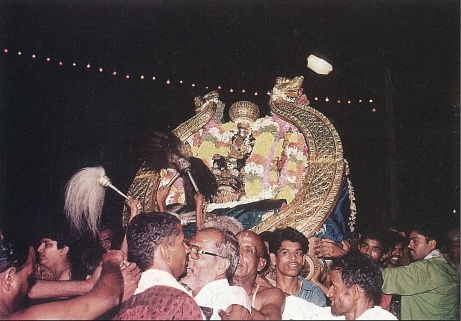By Choodie Shivaram
I visit Melkote a few times every year, as Yoga Narasimha is our family Deity. Yet, we had never ventured to witness the world famous Vairmudi festival held around March-April. The thought of the many people kept us at bay. After joining the Hinduism Today team, I decided to brave the surging crowds and feature this festival. I arrived at Melkote town in Karnataka, India, with my children and parents in the late afternoon. Already, over 200,000 people had converged on this not-so-easily-accessible town. As the sun slid below the horizon, Melkote burst at its seams–all I could see was a sea of human heads.
Built on the rocky hills of Yadavagiri, 90 miles from Bangalore, Melkote is a picturesque temple town. It is the abode of Cheluvanarayana, “Handsome Narayana” and Yoga Narasimha, two forms of Vishnu. To many, Melkote is considered the holy Badrinath of South India. Yadavagiri is one of Vishnu’s 108 sacred abodes. Legends associate Melkote’s existence to the Krita Yuga, the age of Gods, and the diamond crown, Vairmudi, with Lord Vishnu himself.
The Vairmudi procession takes place on the fourth day of a six-day festival. For the entire year the diamond-studded gold crown remains in safe custody at the Government Treasury in Mandya, 17 miles from Melkote. It is only brought out on this auspicious day under armed escort.
The convoy commences its holy sojourn in the afternoon and stops at every village on the way to Melkote. The villagers worship the sealed Vairmudi crown. They believe that the passage of this celestial crown brings prosperity to their village.
The crown arrives at Melkote by dusk and returns to the Government Treasury duly sealed the next morning. Many years ago, the Vairmudi was kept in safe custody at the Royal Treasury in Mysore and brought under the king’s soldier’s watchful eyes by foot and later by horse-drawn carriage.
The parade Deity, Cheluvanarayana, dons the Vairmudi, the crown of diamonds, only at this annual extravaganza. He wears His gem-packed crown for just a few hours, from midnight to dawn. Perched majestically on His vehicular palanquin, Cheluvanarayana proceeds down the streets.
On this day, as we waited with anticipation, the Vairmudi crown arrived by sunset, bringing along with it a much-needed cool breeze. State officials and priests accompanied the diamond crown, which was sealed and wrapped in an antiquated deep blue-velvet bag. Traditional tunes of nadaswaram and temple bells filled the air. Men and women danced to local folk songs about the historic town. On entering Melkote, pujas were performed for the Vairmudi at the Anjaneyaswamy temple at the entrance of the town. The crown is then taken in procession to the main Cheluvanarayanaswamy temple.
Eighty-year-old Vaishnavite priest Kargam Sesha Iyengar, sitting unperturbed by the crowd and confusion inside, makes an inventory of the ornaments without opening their coverings. He then puts his signature on the official records affirming that everything is there. According to the religious practice mentioned in the temple records, Iyengar’s family is the only one entitled to touch the Vairmudi crown. Saint Ramanuja himself, who lived in and supported Melkote some 900 years ago, is said to have assigned the temple duties to various families who have continued their service to this day.
The sealed Vairmudi is taken to the icon of Cheluvanarayana waiting to be crowned behind the privacy of a screen near the shrine of Saint Ramanuja. The lights are switched off and the idol is crowned in darkness. The Vairmudi crown is thought to be of divine origin, and according to legend, anyone who dares look at it while not on the deity risks loosing his eyesight. “I close my eyes so I do not see the crown until it is placed on the idol. I can place it correctly on the idol without difficulty,” said the old priest, Iyengar.
Wearing the diamond-studded crown, Cheluvanarayana, accompanied by His consorts, descends from the platform elegantly seated on His royal chariot, Garuda Vahana. It’s close to midnight, and the Deity and crown begin their sojourn along the narrow streets of Melkote.
As the Deity passed us, I had expected to see a crown of blinding brilliance, but found the Vairmudi a rather simple crown. The diamonds cut centuries ago only glowed when lights fell on them. It is the mystique of the legends that go way back in time that makes the Vairmudi a divine sight. Nothing else matters for the crowds who come long distances and wait for hours only to get a brief glimpse of the Deity. For them, it is the sight of the Lord’s crown crafted in heaven and placed on His head that will remain etched in their memory forever.
